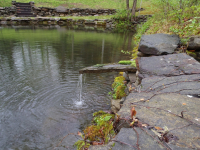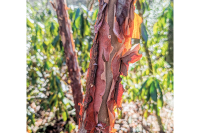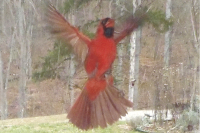Design alteration may come to Waynesville’s South Main Street
An awkward Hazelwood intersection could be scrapped ahead of planned North Carolina Department of Transportation improvements to South Main Street, as long as there’s no opposition from area business owners.
Renaissance on South Main Street
Near the end of 2016, the North Carolina Department of Transportation announced plans for an $18 million makeover of Russ Avenue, including a disastrous modification that would have forever altered the character of one of Waynesville’s most historic neighborhoods.
It’s just a Bojangle’s, but that’s a step up for Waynesville’s South Main
 The commercial revitalization of South Main Street in Waynesville has taken another step forward this month with the bulldozing of a dilapidated, vacant building to make way for a new Bojangle’s.
The commercial revitalization of South Main Street in Waynesville has taken another step forward this month with the bulldozing of a dilapidated, vacant building to make way for a new Bojangle’s.
The run-down corridor has been gradually transforming into a new commercial hotbed since the addition of a Super Wal-Mart on South Main in 2008. The new Bojangle’s to anchor the intersection of South Main and Allens Creek will add another notch to South Main’s belt.
Waynesville’s slow march to a better South Main
A group of vacant, ramshackle buildings at an anchor intersection on South Main Street in Waynesville has been purchased, signaling continued revitalization could be in store for the rag-tag corridor.
Taco Bell to find new home on South Main
Waynesville’s South Main Street continues to see slow but steady commercial growth, with a Taco Bell and Mattress Firm soon to join the ranks of the growing retail corridor.
Community bank expands operations
 When Old Town Bank opened in 2007, its founders already had plans for building a dream headquarters, but the grand plans had to be put on hold until the locally owned bank got on its feet and the recession ended.
When Old Town Bank opened in 2007, its founders already had plans for building a dream headquarters, but the grand plans had to be put on hold until the locally owned bank got on its feet and the recession ended.
South Main renaissance may be in Waynesville’s cards yet
When Super Walmart opened in Waynesville in 2008, it was viewed as just the beginning of a business boom that would reverse a long, steady downward spiral of South Main Street. But, the economy had other plans. The hoped-for land rush of new stores and development along South Main stalled out before it ever got started.
South Main plan dredges up old parking debate
The Waynesville Board of Aldermen approved a revitalization plan for South Main Street last week despite a dispute over one aspect of the proposed design scheme.
The town hired Rodney Porter, a consultant with LaQuatra Bonci in Asheville, last year to study South Main Street. The area has grown increasingly run-down and unattractive. Town leaders hoped new street scheme would promote more economic development along that stretch of road, prompting a year-long public process to develop a new vision for the corridor.
Porter’s report assessing South Main peppered with less-than-flattering language describing South Main: deteriorated condition; not economically healthy; dilapidated structures; no distinct image; scrubby patches of overgrown and unattractive weeds; seldom pedestrian traffic.
Porter addressed the board again last week to show-off his plan to make South Main Street more attractive to developers. His plan includes bike lanes, a continuous sidewalk, a roundabout where Main and Riverbend streets and Ninevah Road intersect, and a four-lane road from Allens Creek Road to Hyatt Creek Road.
The plan received overall positive feedback from the public, but two aldermen and the mayor expressed apprehension about one aspect that seemed to open an old can of worms. Rearing its head again was the ongoing debate over parking lots — namely should parking lots go in front of buildings or be scooted to the side and rear?
Porter felt strongly that parking lots should be to the side and rear, allowing building facades to define the street’s character rather than asphalt and parked cars.
The town of Waynesville had once been in Porter’s camp. Its development standards once required parking lots to sit to the side or rear of buildings, and for facades to flank the street front.
But in response to complaints from developers, the town board recanted and began allowing small, limited parking areas in front of buildings in certain commercial districts, including South Main Street.
In contrast, the consultant wanted the town to go back to its old requirement of storefronts and not parking lots abutting the street — creating a quandary for some of the aldermen.
“Is there a way of modifying this report?” said Mayor Gavin Brown. “I don’t want to have my name on a document that is contrary to another document that I signed less than a year ago.”
Porter stood his ground and fought for the plan to stay as is.
Placing parking lots to the side or back of buildings gives South Main a distinct identity and makes it pedestrian friendly, Porter said. What is the point of creating a plan otherwise, he asked.
“If we pull those buildings back (farther off the street), I really don’t know what we are doing more than putting trees in the sidewalk,” Porter said. “That really sort of strays away from the ‘complete streets’ movement that we have.”
The so-called “complete streets” concept focuses on making a street user friendly for everyone — motorists, cyclists and pedestrians — rather than purely auto-centric.
“It’s not in keeping with complete streets, and you are separating the pedestrian atmosphere with another row of parking,” Porter said. “You would not have the opportunity for any significant street frontage, and depending on how the traffic is laid out, you would quite possibly end up with more curb cuts.”
Curb cuts increase the likelihood of an accident.
Aldermen Gary Caldwell and Julia Freeman sided with Brown, saying they felt uncomfortable approving a plan that runs counter to current land development standards.
“To contradict what we currently have as a land development standard, it’s troublesome to me,” Freeman said.
Paul Black, director of French Broad Metropolitan Planning Organization, voiced his approval of the plan and its commitment to complete streets concept. A parking lot would split the sidewalk and storefronts making it more hazardous for pedestrians, Black said.
“It would be very difficult to have a sidewalk café if the waiter’s got to walk across the parking lot,” Black said. “I don’t know if there is a way to reconcile your development code with the plan.”
Alderman Wells Greeley did not openly express an opinion about the plan, while Alderman LeRoy Roberson endorsed the plan as laid out by the consultant.
After more than an hour of comments and discussion, new Town Manager Marcy Onieal found the plan’s golden ticket to passage — a sentence on page 19 of the report that says all proposed development must meet the town’s land development standards. That means that the town’s ordinances would override any contradictory language proposed in the plan.
The board ultimately passed the South Main Street master plan as is.
“I can live with it,” Brown said.
None of the disagreements will matter, however, once the N.C. Department of Transportation gets its hands on the project. The plan is merely a guideline for DOT, detailing what Waynesville would like to see happen to South Main. But, it is by no means set in stone. DOT could decide to scrap the town’s plan altogether or only incorporate parts of the layout when it revamps the street.
“We’re going to have a big comedown with reality when DOT gets ahold of this and starts designing the road,” said Town Planner Paul Benson. “We are going to get a definite reality check as the program proceeds forward. But, I think at this point I don’t see any problem personally with having sort of an idealized plan out there.”See for yourself
Check out the South Main Street revitalization plan for yourself at www.townofwaynesville.org.
A bold fix for South Main Street
Maybe it’s pie in the sky, but the right ingredients could transform South Main Street into a thriving commercial district. A consultant with LaQuatra Bonci has mapped out a new look for the corridor. The plan banks on new-found aesthetic appeal to create a sense of place, which in turn will make South Main a destination drawing both stores and shoppers.
Problem: Dilapidated buildings, shuttered storeffronts.
Challenge: The prospect of new commercial development is hindered by the ugly appearance and asphalt overload.
Solution: “Green the corridor” with street trees and a planted median.
Problem: How many lanes?
Challenge: The wider the road, the more land that gets lopped off the front of adjacent properties. The resulting lot could be too small to fit anything on. But too few lanes may not support future traffic should it increase substantially.
Solution: Two lanes, except the 0.4-mile stretch in front of Super Walmart between Allens Creek and Hyatt Creek.
Problem: Unfriendly for pedestrians
Challenge: Pedestrian activity can be a magnet for commercial revitalization.
Solution: Create a pedestrian boulevard by installing cross walks, sidewalks and bike lanes.
Problem: Traffic passes through without stopping on its way from point A to point B.
Challenge: South Main lacks a sense of place, giving motorists no reason to slow down or to see South Main as a destination.
Solution: An entrance feature, such as public art piece, to set the stage, along with pedestrian scale lighting and benches.
Problem: Intersections
Challenge: Stoplights require extra turning lanes for cars to queue up in while waiting for the light to change, but the extra turn lanes mean more asphalt and run counter to the street’s new character.
Solution: Use roundabouts instead, which do double duty as a convenient U-turn spot, since the street would have medians preventing left turns in and out of businesses.
Consultant takes bull by the horns in South Main master street plan
South Main Street is a mess.
That’s the message from a consultant hired by the town of Waynesville to develop a revitalization plan for the struggling artery.
The consultant spent six months studying South Main and developing a master street plan. The challenges are great, based on the less-than-flattering language that peppers his report: deteriorated condition; not economically healthy; dilapidated structures; no distinct image; scrubby patches of overgrown and unattractive weeds; seldom pedestrian traffic; high vacancy rate.
Sometimes it takes an outsider to deliver such blunt news, Waynesville Town Planner Paul Benson said. Locals come to accept the status quo, and may not realize how bad it actually looks. Besides, the slow decline of South Main happened over decades, making the changes less noticeable until it became a blight on the town.
SEE ALSO: A bold fix for South Main Street
Many South Main property owners salivated over the coming of Super Walmart and Best Buy, putting their lots and businesses on the market before the big-box development had even broken ground. Four years later, they are still waiting for the land rush, wondering why Applebee’s hasn’t come knocking yet.
The answer is because South Main Street simply doesn’t look good, according to Rodney Porter, the corridor consultant who works for LaQuatra Bonci in Asheville.
“One of the challenges to this corridor is how do we make the road itself more accessible and pedestrian friendly. The other is how do we address the economic downturn of this corridor,” Porter said.
Luckily, the solution happens to be one and the same, he said.
“If you can design a road that is pedestrian friendly you can generate a more successful corridor,” Porter said. “A simple change of image will provide a new address for economic investment.”
The same elements that would make the road attractive to pedestrians — sidewalks, curbs, street trees, crosswalks, benches, a landscape median — will make it attract to commercial development, Porter contends.
“Pedestrian traffic is a critical ingredient to revitalizing a corridor,” Porter said. “It is critical to have this corridor be inviting and provide a sense of safety and welcome.”
Failure to do so could forever sentence South Main to its destitute status, according to Porter’s assessment. Traffic on South Main Street has actually declined over the past three years, according to traffic counts taken by the DOT shortly after Super Walmart opened and new traffic counts taken by Porter’s team.
“More people are actually going around South Main Street to get to Walmart. They are just hopping off the exit,” Porter said.
They aren’t being drawn to South Main, and instead opt to hop on and off the adjacent highway to get to Walmart. Until South Main’s appearance improves and lures more traffic, new businesses won’t be motivated to follow suit, Porter said.
“Until you set the stage with a new road coming in, there is no incentives for redevelopment along that road,” Porter said.
Benson agrees with the premise: make the street attractive and inviting, people and businesses will follow.
“It needs to be a more attractive environment,” Benson said. “That will be a key to promote retail activity.”
It will take more than throwing in a row of trees along the road and putting in sidewalks, however.
The road itself is missing many of the bare essentials. It lacks curbs, with parking lot after parking lot morphing into the road. The net result: a giant plain of asphalt.
Porter said South Main’s character is defined by the “overwhelming presence of parking lots.”
In the quest to bring renewed life to South Main, the middle-class neighborhoods of Hazelwood will be critical, according to Porter.
“The lack of users on South Main Street has in part contributed to the dereliction of the corridor,” Porter said. “The adjacent residential population is no longer devoted to the commerce on South Main Street.”
Benson agreed on this point as well.
“The idea is to connect with the neighborhoods, to make it easy for those folks to walk or ride their bike or drive to the corridor. A lot of it is based on a complete street concept that all users should feel comfortable on the corridor, not just the cars and trucks,” Benson said.
What’s next?
Porter was hired by the town to develop a proposed plan for South Main Street as a community-driven alternative to another plan devised by the N.C. Department of Transportation.
The DOT plan was less nuanced and more utilitarian. It calls for a wider road with fewer pedestrian features — concrete rather than planted medians, no dedicated bike lanes, narrower sidewalks and more lanes.
The town felt it wasn’t in keeping with its vision for South Main, and that’s largely what prompted the town to undertake an independent master plan.
“This is definitely a more tailored approach than the DOT study,” Benson said.
The town’s independent feasibility study cost $55,000, with 80 percent of the cost paid for with a federal planning grant.
Two community workshops were held to engage the public in creating the plan. Property owners, businessmen, as well as average residents, turned out to voice their vision for the corridor.
The town is now hoping the public will voice its opinions again now that a draft plan is on the table. A meeting to solicit input will be at 5:30 p.m. Tuesday, Jan. 17, at the new Waynesville town hall building.
Porter said “community consensus” is important to the success of the plan.
Based on the feedback, the consultant will finalize the plan before its adopted by the town. The town will then present its plan to the DOT in hopes of seeing the features it wants incorporated.
The DOT has cautioned that its feasibility study of South Main wasn’t intended as a detailed street design.
“It is not the Bible. It is not the final word on what is going to happen,” said Derrick Lewis, DOT road planner in Raleigh overseeing the DOT’s South Main feasibility study. “As a project moves thru the planning and design stages, the number of lanes, as well as the intersection configuration and design are always up for discussion based upon updated information and community input.”
The feasibility study took a broad look at how to best accommodate projected traffic 25 years from now. Details would not be hammered out in the final design stage.
Lewis said the DOT will listen to the town’s recommendations and decide whether to incorporate any of them. The DOT’s feasibility study is still considered in draft form.
“We put it in the holding pattern to see if there are any magic bullets come out of this study,” Lewis said.
Benson hopes the DOT will be receptive.
“I’m hoping he will look at this and won’t have any problem with what we came up with,” Benson said.
Based on a surface reading of the town’s plan, Lewis noticed several design features that may not jive with DOT street standards.
Want to weigh in?
Public input is sought on a plan to makeover South Main Street in Waynesville. A proposal to turn it into a vibrant, tree-line boulevard with pedestrian appeal will be presented at 5:30 p.m. Tuesday, Jan. 17, at the new Waynesville town hall building.
Ideas and critiques from the public will be solicited. To view the plan click here.









